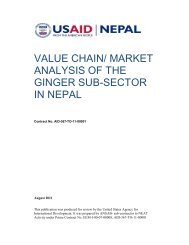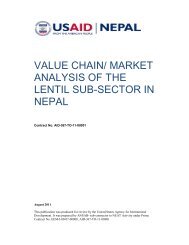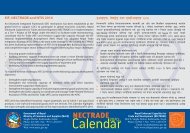value chain/ market analysis of the orthodox tea sub ... - Nepal Trade
value chain/ market analysis of the orthodox tea sub ... - Nepal Trade
value chain/ market analysis of the orthodox tea sub ... - Nepal Trade
Create successful ePaper yourself
Turn your PDF publications into a flip-book with our unique Google optimized e-Paper software.
1. INTRODUCTION1.1 BackgroundANSAB is an independent, non-pr<strong>of</strong>it, civil society organization that has been working inSouth Asia since 1992. ANSAB is committed to biodiversity conservation and economicdevelopment through community-based oriented solutions. ANSAB is <strong>the</strong> pioneer indeveloping and applying new approaches to promote natural product-based enterprises and<strong>value</strong>-<strong>chain</strong> interventions in <strong>Nepal</strong>. With its exemplary track record, competent <strong>tea</strong>m, andwide networks, ANSAB has designed and successfully completed hundreds <strong>of</strong> relatedprojects including <strong>value</strong> <strong>chain</strong> studies <strong>of</strong> commercially important products with tangibleresults. It has also provided different expert services to stakeholders working in <strong>Nepal</strong> ando<strong>the</strong>r neighboring countries. In this context, ANSAB was awarded an assignment underNEAT to conduct a <strong>value</strong> <strong>chain</strong>/<strong>market</strong> study <strong>of</strong> selected agricultural commodities including<strong>orthodox</strong> <strong>tea</strong>.Agriculture in <strong>Nepal</strong> has long been based on <strong>sub</strong>sistence farming, particularly in <strong>the</strong> hillyregions where farmers make earn <strong>the</strong>ir livings from fragmented plots <strong>of</strong> land cultivated indifficult conditions. The economic well being <strong>of</strong> <strong>Nepal</strong> is very closely bound to naturalresources arable land, water, and forest areas. Although only comprising about 21 percent<strong>of</strong> land area, agricultural land is <strong>the</strong> major determinant <strong>of</strong> economic activities and <strong>the</strong> nationssocio-political identity; it provides employment opportunities to 66 percent <strong>of</strong> <strong>the</strong> totalpopulation and contributes about 36 percent in <strong>the</strong> GDP 1 . Most <strong>of</strong> <strong>the</strong> agriculture householdsare smallholders. About 45 percent <strong>of</strong> <strong>the</strong> farming households have less than 0.5 hectares (ha)<strong>of</strong> land and poverty is widespread. Poverty is much more severe in rural areas (35 percent)compared to <strong>the</strong> urban areas (10 percent) (CBS 2004). Farming remains primarily<strong>sub</strong>sistence-oriented and only a small portion <strong>of</strong> farms use modern production units.Agricultural growth in <strong>Nepal</strong> is constrained by poor infrastructure, weak institutions, andinadequate technical support for commercialization and supply <strong>chain</strong> development.<strong>Nepal</strong>'s foreign trade is in a deficit. There is a domestic increase in demand every year forforeign goods as well as high consumption with a static trend in export growth. In thiscontext, <strong>the</strong> National <strong>Trade</strong> Integration Strategy (NTIS), 2010 has prioritized 19 commoditieswith export potential, among <strong>the</strong>m, <strong>tea</strong> is one (MoCS, 2010).In <strong>Nepal</strong>, <strong>the</strong> history <strong>of</strong> <strong>tea</strong> cultivation began in 1863 with <strong>the</strong> establishment <strong>of</strong> <strong>the</strong> Ilam TeaEstate in <strong>the</strong> hills and later in <strong>the</strong> mid hills <strong>of</strong> Soktim. The first <strong>tea</strong> plantation in <strong>the</strong> privatesector was Budhhakaran Tea Estate which was established in 1959 in <strong>the</strong> plains <strong>of</strong> <strong>the</strong> Terai.With <strong>the</strong> establishment <strong>of</strong> <strong>the</strong> <strong>Nepal</strong> Tea Development Corporation (NTDC) in 1966 by <strong>the</strong>Government <strong>of</strong> <strong>Nepal</strong>, <strong>the</strong> commercial cultivation <strong>of</strong> <strong>tea</strong> increased. In 1982, <strong>the</strong> governmentrealized <strong>the</strong> potential <strong>of</strong> <strong>tea</strong> as a viable crop and export commodity. The GON declared fivedistricts - Jhapa, Ilam, Panchthar, Tehrathum and Dhankuta as <strong>Nepal</strong>s Tea Zone andprovided support to <strong>the</strong> <strong>tea</strong> growers and processors.The growth and development <strong>of</strong> <strong>the</strong> <strong>tea</strong> sector increased after <strong>the</strong> economic liberalizationprocess which was initiated in 1991 and <strong>the</strong> private sectors and small holder farmersparticipated actively towards commercial <strong>tea</strong> cultivation. In 1992, <strong>the</strong> <strong>Nepal</strong> Tea and C<strong>of</strong>feeDevelopment Act was introduced and <strong>the</strong> legislation paved <strong>the</strong> way for provisions on <strong>the</strong>1 http://www.moac.gov.np/Value Chain/Market Analysis-Orthodox Tea 3






